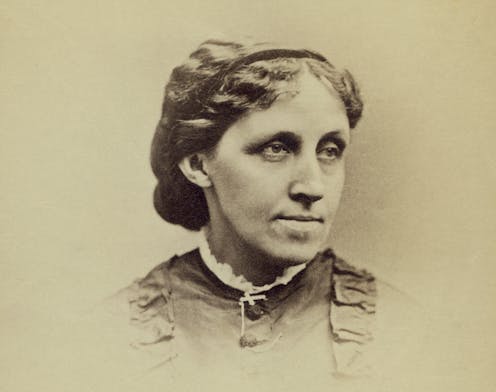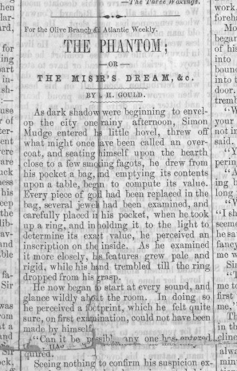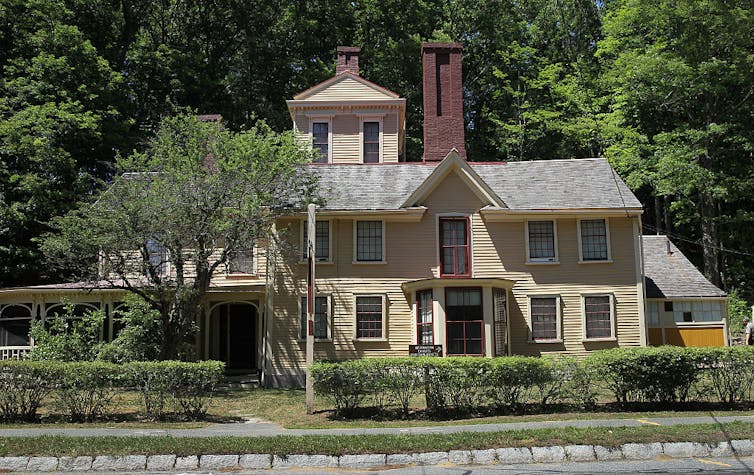
Before Louisa May Alcott published the bestselling “Little Women” in two volumes – the first in 1868, the second in 1869 – she wrote melodramatic thrillers, selling these short stories to magazines to bring in cash for her impoverished family.
On a cold November day in 2021, I was rereading Madeleine B. Stern’s introduction to her 780-page edition of “Louisa May Alcott’s Collected Thrillers.”
In the 1940s, Stern, with her research partner Leona Rostenberg, helped reveal that Alcott had written many of these sensational tales under the pseudonym A. M. Barnard.
But Stern wondered if any other stories written by Alcott were still out there.
For example, in “Little Women,” Jo March – the character who most closely resembles Alcott – also writes short stories to support her struggling family.
“‘A Phantom Hand’ put down a new carpet,” Alcott writes, “and the ‘Curse of the Coventrys’ proved the blessing … in the way of groceries and gowns.”
Stern points out that there’s a related reference in Alcott’s journals – “not to ‘A Phantom Hand’ but to ‘A Phantom Face,’ for which she earned $10 in 1859.”
“But,” Stern adds, “neither the ‘Phantom Hand’ nor the ‘Phantom Face’ has been tracked down.”
At the time, I was a graduate student working on my dissertation. I was on the hunt for pseudoscientific short stories, so the mention of Alcott’s missing tales piqued my interest.
Where was this phantom “Phantom” story? Could I find it?

After searching digital databases, I came across one such story, called simply “The Phantom,” with the subtitle, “Or, The Miser’s Dream, &c.” It had been published in the Olive Branch in early 1860, months after Alcott listed having written “The Phantom” in her journals. But the byline under the story read E. or I. – I couldn’t quite make out the first initial – Gould, which wasn’t a known pseudonym of Alcott’s.
So I went to sleep. Sometime later I awoke with the thought that Gould might be Alcott. What if, along with her several known pseudonyms – A. M. Barnard, Tribulation Periwinkle and Flora Fairfield, among others – Alcott had yet another that simply hadn’t been identified yet?
I cannot say for certain that Gould is Alcott. But I’ve encountered enough circumstantial evidence to consider it likely Alcott wrote seven stories, five poems and one piece of nonfiction under that name.
More clues emerge
The publication dates of Gould’s stories – and the outlets where they appeared – certainly suggest Alcott’s authorship.
From the mid-1850s onward, Alcott regularly churned out stories, and yet the record leaves a noticeable gap between spring 1857 and late 1858. In one of Alcott’s letters from the period, she wrote to a friend asking if the magazine Olive Branch would be interested in more of her work. Years earlier, in 1852, Alcott had published “The Rival Painters” in that magazine. Until now, all scholars assumed it was her only story published in the Olive Branch.
In the course of my sleuthing, I found several other pieces that were written by Alcott or had likely been written by her, including a 1856 Saturday Evening Gazette piece called “The Painter’s Dream” and an anonymous Olive Branch story from 1857, “The Rival Painters: A Tale of Florence.”
The latter “Painters” was published in the exact period – and in the same magazine – as many of the Gould pieces. Several other outlets that published Gould also have connections to Alcott. For example, one of the Gould stories appears in the magazine Flag of Our Union, where Alcott later published under the Barnard pseudonym.
But to me, the clearest evidence connecting Gould to Alcott comes from the stories themselves. The name Alcott serves as the last name of the protagonists in two of Gould’s stories. Additionally, “The Wayside” – the name of one of Alcott’s homes – is the title of a nostalgic piece of nonfiction authored by Gould.

The stories also resemble Alcott’s early fiction in important ways. As I argue in one of my dissertation chapters, Alcott pioneered the “sensation” genre. These stories combined elements of sentimental tales with melodramatic thrillers. Instead of taking place in European castles and British landed estates, they were set in the types of places that would have been familiar to the emerging American middle class, such as doctors’ offices and insane asylums. Alcott’s stories show how tensions of gender and class can make those mundane spaces fraught with danger and possibility.
At the same time, there are signs that Gould might not be Alcott. Gould was a common name, especially around Boston. Alcott also kept lists of her stories, and only one of the Gould pieces – “The Phantom” – shows up on those long lists.
However, evidence suggests that the lists aren’t exhaustive – some stories appear on one list but not another – and Alcott refers to stories in her diaries that don’t appear on any lists.
Pseudonyms and guessing games
Why would an author like Alcott use pseudonyms anyway?
For one, Alcott was poor. So early in her career she wrote and published for money, and she might not have been particularly proud of everything she wrote. By disguising her name, Alcott could publish in less prestigious venues for a quick buck without worrying about tarnishing her literary reputation.
Even though she was poor, Alcott’s family had wealthy and cultured connections. Among them was Henry David Thoreau who, in “Walden,” disparaged the Olive Branch as one of the papers spreading “the gossip of Boston.” And while Alcott’s own mother often praised her writing, she did so only when the Alcott name was printed in more highly regarded venues, like The Atlantic.
Pseudonyms also allowed Alcott to write about topics she might not have felt comfortable attaching her name to. Many stories written under the Barnard pseudonym depict drug use, reverse gender roles and discuss class conflict in ways that were radical for the late 1850s.
A culture awash in authorial ambiguity
Are there any other Alcott stories that remain unidentified? I would say there almost certainly are. As to whether Alcott used any pseudonyms in addition to the ones that have been identified, that’s less likely but possible.
However, I also hope that the identification of Gould restarts a conversation about authorship, especially for literary figures of the past.
Alcott found herself awash in authorial ambiguity. Her first Olive Branch story, “The Rival Painters,” appeared next to a short essay by the wildly famous and pseudonymous Fanny Fern, who was a master at manipulating public perceptions.
After the blockbuster success of “Little Women,” Alcott published a novel, “A Modern Mephistopheles,” as part of the “No Name Series.” Released by the publishing house Roberts Brothers, the collection featured books written anonymously by famous writers. Readers would try to guess the real authors, but Alcott didn’t reveal she wrote the novel until a few months before her death.
Alcott was deeply embedded in a culture of unknown, and yet guessable, authorship. Anonymity liberated Alcott, Fern and other writers – particularly women – by allowing them to tackle risky topics. But anonymity and pseudonyms didn’t stop people from sleuthing, now or then. Readers delighted in trying to figure out an author’s possible masks, just like I’m doing now with Gould. And it wasn’t just readers: Editors and writers withheld information while at the same time leaving clues. Everyone got in on the fun of hidden identities.
I’ll keep gathering evidence that may either prove or disprove Alcott’s authorship of Gould’s stories. But if I never know, that’s fine with me.
Alcott herself loved acting, and she loved wearing masks, both literally on the stage and figuratively in print. In the spirit of the masquerade, the Gould pseudonym adds to the allure of mystery – and the joy of discovery.
Max Chapnick first presented this research at the American Literature Association Conference in 2022, where he recieved funding from the Louisa May Alcott Society of which he is also a member.
This article was originally published on The Conversation. Read the original article.







